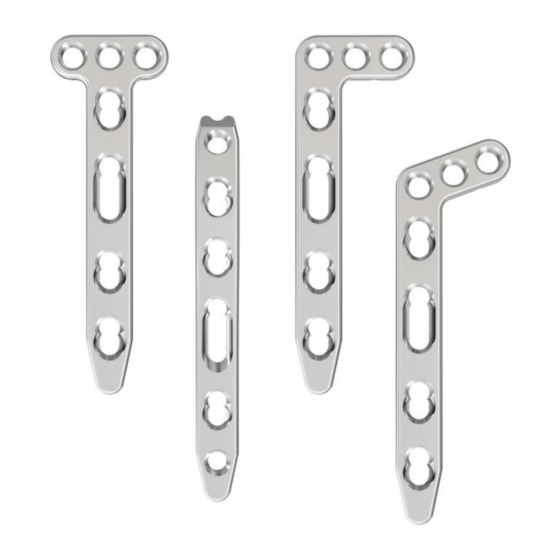
Advertisement
Quick Links
Advertisement

Summarization of Contents
Distal Radius Plates Overview
Indications
For fixation of fractures and osteotomies, including carpal fusions involving the distal radius.
Features
Dorsal and volar plates available, precontoured, cut-to-length, elongated holes, stainless steel/titanium.
Unique Distal Articular Plate Arms
Accept buttress pins or cortex screws for fixation, providing multi-point fixation and ability to buttress small fragments.
Distal Radius Plate Types
Dorsal Distal Radius Plate
Precise anatomical contour minimizes Lister's tubercle removal; two proximal legs for independent fixation planes.
Volar Distal Radius Plate
20° AP bend for volar surface, 18° angulation for radial inclination, 10° for distal plate placement.
Implants
1.8 mm Buttress Pin
For distal plate arms in articular fractures or poor bone quality, providing fixed pin-plate construct and buttress.
2.4 mm Self-Tapping Cortex Screw
For distal plate arms to provide fixation for articular surface restoration, used with good bone quality or large fragments.
2.7 mm Self-Tapping Cortex Screw
For use in the proximal plate legs. Standard self-tapping screws also available in mini fragment sets.
Dorsal Surgical Approach
Initial Incision and Exposure
Make a longitudinal incision over the dorsal radius between extensor compartments 2 and 3, then open extensor retinaculum.
Compartment Mobilization and Elevation
Elevate and mobilize the third compartment (EPL tendon) and elevate compartments 2 and 4 subperiosteally.
Dorsal Plate Technique: Shaping and Contouring
Shape Template
Temporarily position bending template to verify plate length and contour, compare to distal radius plate.
Cut Plate
Cut plate using bending/cutting pliers between holes, ensuring underside faces tip of pliers.
Contour Distal Plate Arms
Use bending irons to contour articular arms to fit distal radius, creating convex bends in small increments.
Contour Proximal Plate Legs
Use bending pliers to gently contour proximal legs to fit the distal shaft of the radius.
Dorsal Plate Technique: Securing the Plate
Apply Plate
Place plate on distal radius, determine fixation holes based on fracture pattern and clinical situation.
Secure Distal Arms with Buttress Pins
Use 1.8 mm threaded drill guide, drill bicortically, measure depth, and insert buttress pin.
Secure Distal Arms with Cortex Screws
Use 2.4 mm drill guide and bit, drill bicortically, measure depth, and insert 2.4 mm self-tapping cortex screw.
Secure Proximal Legs
Place 2.7 mm universal drill guide, drill with 2.0 mm bit, measure depth, and insert 2.7 mm self-tapping cortex screw.
Dorsal Closure
Protect Soft Tissues
Leave compartments 2 and 3 (tendons) above extensor retinaculum at wound closure to protect soft tissues.
Volar Surgical Approach
Incision and Exposure
Longitudinal incision on radial border of distal forearm, access fracture via radial incision of pronator quadratus muscle.
Precautions
Imperative not to open volar wrist capsule to avoid devascularization and destabilization of wrist ligaments.
Volar Plate Technique
Follow Dorsal Technique
Follow dorsal surgical technique outlined in steps 1-7, use appropriate method for surgical closure of the incision.
Distal Radius Plate Instrument and Implant Sets
Instruments
List of instruments including drill bits, quick coupling, handles, guides, depth gauges, bending irons, pliers, and screwdrivers.
Implants
List of implants including cortex screws, buttress pins, Kirschner wires, and plates (dorsal/volar, right/left).
Also Available
Additional items include Titanium Distal Radius Implant Module and Mini Lengthening Apparatus.













Need help?
Do you have a question about the Volar and is the answer not in the manual?
Questions and answers